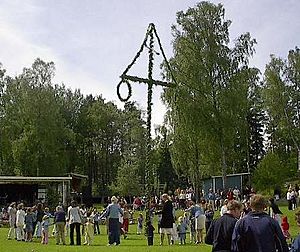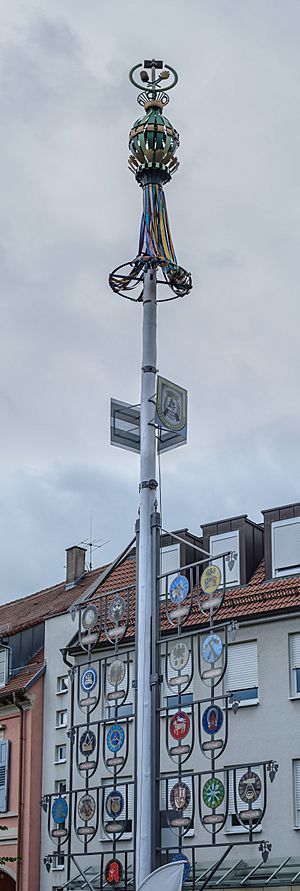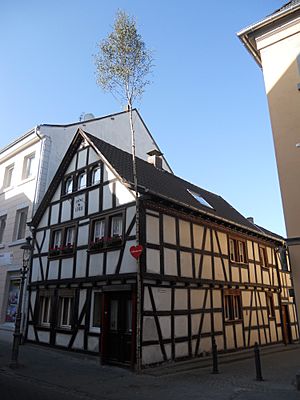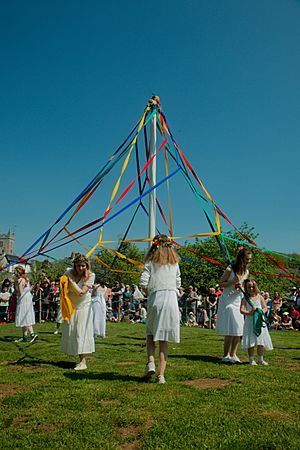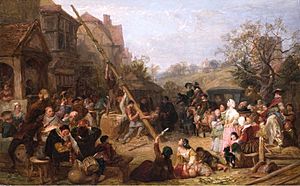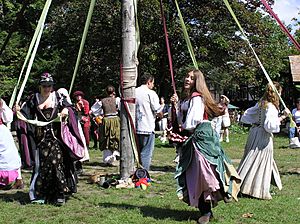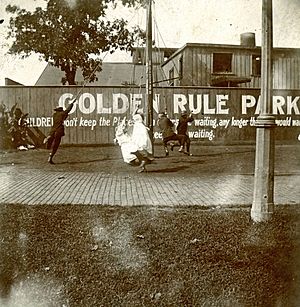Maypole facts for kids
A maypole is a tall wooden pole that people put up for different European folk festivals. Often, a maypole dance happens around it.
These festivals usually take place on May 1st or during Pentecost (also known as Whitsun). In some countries, the maypole is put up for Midsummer (around June 20-26). Sometimes, the maypole is a permanent part of a village. Other times, it is set up just for the festival and then taken down.
Maypoles are mostly found in countries where Germanic languages are spoken, and in areas they have influenced. We don't know exactly where the tradition started. Some people think maypoles were important in Germanic paganism long ago, before Christianity. They believe the tradition continued even after people became Christian, but its original meaning was lost. Maypoles have been used in Europe for many centuries. They became less popular in the 1700s and 1800s. Today, people still celebrate with maypoles in some parts of Europe and in European communities in the Americas.
Contents
What Maypoles Mean

Historian Ronald Hutton agrees with a Swedish scholar who said that maypoles were put up simply as "signs that the happy season of warmth and comfort had returned." Their shape was perfect for hanging garlands. In the British Isles, the first maypoles appeared between 1350 and 1400. In 1588, people in Exeter gathered around a 'summer rod' for feasts.
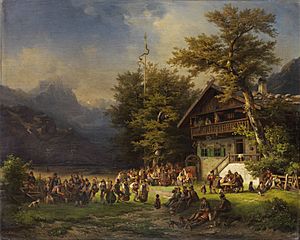
People have debated what maypoles mean for a long time, but there is no single answer. Some scholars think maypoles are symbols of the world's center, like a connection between heaven and earth. Since they were mainly in Germanic areas, where Germanic paganism was once practiced, some believe maypoles are a leftover from those old traditions. One idea is that they represent sacred trees, which were important to pagans. However, Ronald Hutton says there is "absolutely no evidence" for this.
Another idea is that maypoles are simply part of the joy of summer returning and new plants growing. This is similar to the May Day garlands used in Britain and Ireland.
Maypole Traditions Around the World
Maypoles in Germany and Austria
In Germany and former Austro-Hungarian countries, the maypole (called Maibaum) tradition goes back to the 1500s. It's a decorated tree or tree trunk. It's usually put up on May 1st or the evening before. In many areas, especially in Bavaria and Austria, there's a special ceremony to raise the maypole in the village square. This custom often includes a village festival on April 30th, May 1st, or at Pentecost.
In the Bavarian Alps, raising the traditional maypole on May 1st is a big celebration. The pole is usually painted white and blue, which are the Bavarian colors. It's decorated with symbols showing local crafts and businesses. In Bavaria, the Maibaum is put up several weeks before May 1st. Young men from different villages sometimes try to steal each other's Maibaum. If a village succeeds, the village that lost its pole has to invite the thieves for free beer and a party on May 1st.
Before the Maibaum is raised, there might be a parade through the village. Crowds watch, and a brass band often plays music. The young men decorate the maypole with symbols of different trades. Traditionally, the maypole is set up using long poles. Today, sometimes tractors or cranes are used.
In the Rhineland area around Cologne, there's a different maypole tradition. On the night before May 1st, unmarried men put young birch trees in front of their sweethearts' houses. These trees can be very tall and are decorated with colorful paper and a red wooden heart with the girl's name.
If the tree is put up on the eve of May 1st, a May dance (Tanz in den Mai) often follows. Depending on local custom, the Maibaum might stay up all year or be taken down at the end of May.
Maypoles in Nordic Countries
In Denmark, the maypole tradition is almost gone. But it's still celebrated on the islands of Avernakø and Strynø, and in a few villages in southern Himmerland. The maypole is usually called a majtræ, meaning "May tree."
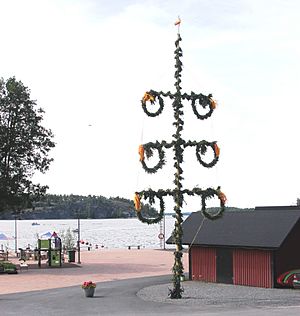
In Sweden and Swedish-speaking parts of Finland, the maypole is usually called a midsummer pole (midsommarstång). This is because it's used for Midsummer celebrations. The word maj in majstång comes from an old Swedish word meaning 'dress,' not the month of May.
The traditions and designs of the poles vary. A common design has a cross and two rings. An older design, still used in Småland, Sweden, has a large horizontal ring hanging from ropes at the top. Traditional ring dances are common in Sweden. Participants dance and make movements based on songs, like pretending to wash clothes or jumping like frogs. These dances are very popular with young children.
- Erection of midsommarstång, Sölvesborg 2013
Maypoles in Belgium
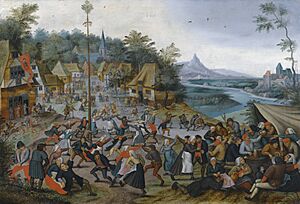
In Belgium, the Maypole is called Meiboom or Meyboom. Hasselt puts up its Meiboom on April 30th. In Brussels and Leuven, the Meyboom is traditionally put up on August 9th before 5 PM.
The planting of the Meyboom is part of a friendly competition between Brussels and Leuven. This rivalry dates back to 1213. In 1974, a group from Leuven managed to steal Brussels' chosen tree and put it up in Leuven. Brussels says they didn't lose their right because they still put up another tree before 5 PM on August 9th.
It's also common in Dutch-speaking Belgium to place a branch (also called a Meiboom) on the highest point of a building being built. This often leads to a celebration for the workers and neighbors.
Maypoles in the United Kingdom
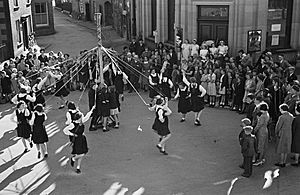
In the United Kingdom, maypoles were mainly found in England and parts of Scotland and Wales influenced by England. The first record is from a Welsh poem in the mid-1300s, describing a tall birch pole at Llanidloes, Wales. By 1350-1400, the custom was common across southern Britain.
Maypoles became "communal symbols" that brought communities together. Sometimes, poorer villages joined with neighbors to get a pole. In other cases, people stole poles from nearby communities, which sometimes led to fights.
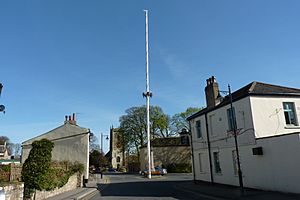
When Protestantism grew in the 1500s, some Protestants didn't like maypoles. They saw them as wrong. Under King Edward VI, many maypoles were destroyed. But when Mary I became queen, she brought back Roman Catholicism, and maypoles returned. Later, the practice was sometimes banned in certain areas but continued in others. In Scotland, Protestantism became very strong and largely stopped the use of maypoles.
During the English Interregnum (a time when England had no king), maypole displays were banned. The government called them "Heathenish vanity." However, people still secretly put them up. The ban made maypole dancing a symbol of resistance against the government.
The church of St Andrew Undershaft in London is named after a maypole that was kept there. It was set up every spring until 1517. The maypole itself was destroyed in 1547 by a group who saw it as a "pagan idol."
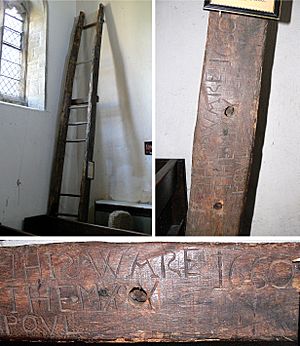
When the king returned in 1660, people in London put up maypoles "at every crossway." The largest was the Maypole in the Strand, which was over 130 feet tall. It stood until 1672 when it was blown over. Later, it was used by Sir Isaac Newton for his telescope.
In the countryside, maypoles and dances came back after the king returned. By the 1800s, the maypole became a symbol of "Merry England." The idea of adding ribbons to weave around the pole became popular in the 1800s.
Today, the dance is done by pairs of boys and girls (or men and women). They stand around the pole, each holding a ribbon. They weave in and out, boys going one way and girls the other. The ribbons weave together around the pole until they meet at the bottom. More complex dances exist for practiced dancers. These dances are performed every Mayday around the permanent Maypole at Offenham, in Worcestershire. Temporary Maypoles are usually put up on village greens.
In some regions, people carried decorated sticks with hoops or cross-sticks. These were covered with flowers, greenery, or paper. Children would take these to school on May Day morning, and prizes might be given for the best ones. This tradition was called garlanding.
The tallest maypoles in Britain are in Nun Monkton, North Yorkshire (88 feet), Barwick-in-Elmet, West Yorkshire (86 feet), Welford-on-Avon, Warwickshire (65 feet), and Paganhill, Gloucestershire (60 feet).
Maypoles in Ireland
Holywood in County Down, Northern Ireland, has a maypole in the town center. It is the only maypole in Ireland. Its origin is uncertain, but it might date from the 1700s. The latest maypole was damaged in a storm in 2021 and is being replaced.
Maypoles in the United States
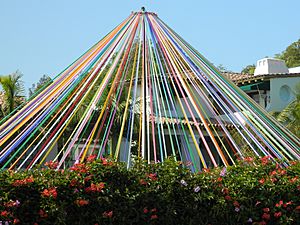
While not widely celebrated by everyone in the United States today, a Maypole dance similar to the one in the United Kingdom is an important part of May Day celebrations in local schools and communities. Often, the Maypole dance is part of a larger show for the public.
The earliest use of a Maypole in America was in 1628. William Bradford, the governor of New Plymouth, wrote about a group of servants who set up a maypole in their own settlement. They danced around it and invited Native American women to join them. Governor Bradford did not approve of their behavior.
Governor Bradford's disapproval of the Maypole tradition was a key part of Nathaniel Hawthorne's story "The Maypole of Merry Mount," published in 1837.
Maypoles in Italy
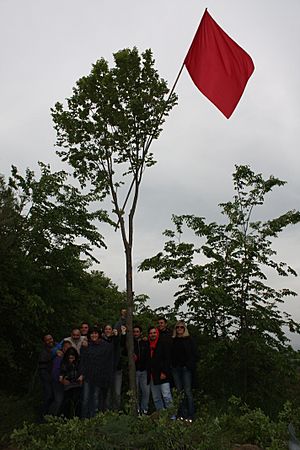
Maypole traditions are found in some parts of Italy, like Veneto, Friuli, Umbria, and Marche. In Marche, the tradition dates back to the time of Napoleon, when the "tree of liberty" (a symbol of the French Revolution) arrived in Italy.
In the late 1800s, the maypole tradition in southern Marche became a socialist ritual. A red flag was placed at the top of the tree. In the second half of the 1900s, the maypole became a symbol for farmers who were fighting for better living conditions. Even today, on the night of April 30th, in many villages, people cut a poplar tree, put up a red flag, and raise the tree in village squares.
The same ritual happens in Lamon, a village in the Dolomites in Veneto. Here, a larch tree is used, with most branches removed except at the top. A red flag is usually attached, but sometimes other flags are used. Around the maypole, villages have parties with music and food that last until May 1st morning. The maypole is called 'Majo' there.
Maypoles in Canada
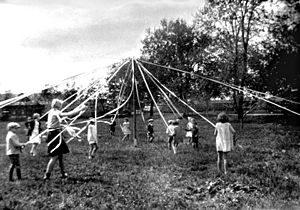
In Canada, maypole dances are sometimes part of Victoria Day celebrations in May. In New Westminster, British Columbia, maypole dancing and May Day celebrations have been held for 149 years.
Maypoles in Stories
Poet Jonathan Swift described a maypole in his poem "A Maypole":
Deprived of root, and branch, and rind,
Yet flowers I bear of every kind:
And such is my prolific power,
They bloom in less than half an hour;
"The May-Pole of Merry Mount" is a short story by Nathaniel Hawthorne. It was first published in 1832. The story is about a young couple who get married near a Maypole and face disapproval from the Puritans. Hawthorne based his story on real events from colonial New England history.
See Also
- Axis Mundi
- Beltane
- Ceremonial pole
- Sacred trees and groves in Germanic paganism and mythology
- Walpurgis night


